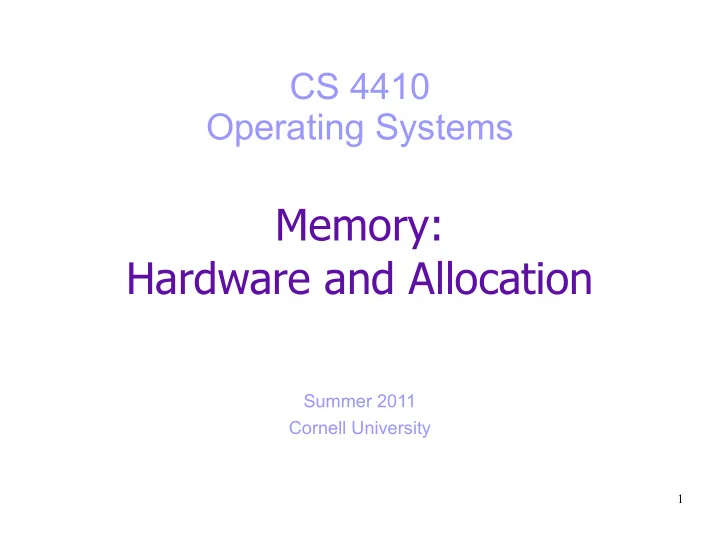

CS 4410 Operating Systems Memory: Hardware and Allocation Summer 2011 Cornell University 1
Today ● How the memory is shared among the ready processes? ● Memory ● Address protection ● Logical vs Physical Address ● Contiguous memory allocation 2
Storage Hierarchy Hard Disk Memory Cache (L1, L2, L3) Registers 3
Memory ● A large array of words. ● Word = 4 or 8 bytes. ● One address for every word. ● Content: ● Instructions ● Data 4
Instruction execution cycle ● Fetch instruction from memory. ● The PC saves its address. ● Decode instruction. ● Fetch operants form memory . ● Execute the instruction. ● Store result in memory . ● Program and data should be in Memory to become useful. 5
Memory Management Is memory shared between processes? How? ● Monoprogramming ● Only one process is ready and loaded into memory. ● It shares the memory space with the OS. ● Is it efficient? ● Multiprogramming ● Fixed or variable partitions for every ready process. ● 2 problems: relocation, protection. Solutions? ● Timesharing ● Swapping ● Entire process (code, data) is transferred from disk to memory, and vice – versa. Virtual Memory ● Processes can run when they are partially in the memory. – 6
Memory Management ● What about the memory addresses? ● Monoprogramming – The physical addresses are known to the programmer. ● Multiprogramming – The physical addresses are known at the loading time. ● Timesharing – The physical addresses are known at the execution. – The CPU understands logical addresses. – The Memory understands physical addresses. 7
Memory Management ● Basic concerns: ● Allocation ● Relocation ● Protection 8
Hardware address protection ● Multitasking OS ● Multiple processes loaded in the memory. ● Each process has a separate memory space. ● HW+OS are responsible for address protection. 0 OS 25600 base process 30004 30004 process 42094 12090 process limit 88000 9
Logical vs Physical Address ● Multitasking OS ● Memory management: Swap, Virtual Memory ● Logical Address ● Address generated by the CPU ● Address loaded into PC ● Address used in a program ● Physical Address ● Address seen by the memory unit 10
Address Binding Logical → Physical ● Execution time ● Logical Address ↔ Virtual Address ● Memory-Management Unit (MMU) ● Relocation Hardware device ● register Run-time mapping 14000 ● Physical Logical address address CPU + memory 346 14346 11
Dynamic Loading ● Using Virtual memory: ● Better memory-space utilization ● The main program is loaded into memory. ● A routing of the program is not loaded until it is called. ● It is users' responsibility. 12
Dynamic Linking ● Using Virtual memory: ● Without this, each program should include a copy of its language library. ● It waists disk and memory space. ● With Dynamic Linking: ● A stub substitutes a library-routine reference. ● When stub is executed: – It checks if the routine is in the memory. – If not, the program loads the routine. 13
Contiguous Memory Allocation Share memory between OS and multiple processes. ● Each process is contained in a single contiguous section in memory. ● Memory protection: ● CPU scheduler selects process for execution. ● The dispatcher loads the relocation and limit registers. ● limit relocation register register logical yes address memory + CPU < physical address no trap: addressing error 14
Allocation Strategies ● Fixed-sized partitions ● The degree of multiprogramming is bound by the number of partitions. ● Variable-partition scheme ● The OS keeps a table indicating which parts of memory are available and which are occupied. ● The OS tries to fit the memory demands of a process in the available memory space. ● Dynamic storage allocation problem: – First fit – Best fit – Worst fit 15
Fragmentation ● External fragmentation ● First-fit, Best fit ● There is enough total memory space to satisfy a request but the available spaces are small and not contiguous. ● Solution 1: Break the physical memory into fixed-sized blocks and allocate memory in units based on block size. ● Internal fragmentation: the allocated memory is slightly larger than the requested memory. ● Solution 2: Compaction 16
Today ● How the memory is shared among the ready processes? ● Memory ● Address protection ● Logical vs Physical Address ● Contiguous memory allocation 17
Recommend
More recommend